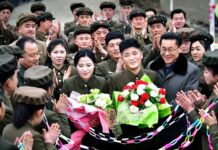The annual Korean rainy season has taken its toll on South Korea, with a recent storm taking one life and injuring a further 200.
North Korea’s Chosun Central TV reported on the 14th that 172mm had fallen in the Pyongkang region of Kangwon Province, the highest one-day rainfall figure in the country. The rains were caused by an atmospheric effect coming in off the West Sea, according to the report.
The report listed recent rainfall by region, noting that in addition to Pyongkang at 172mm; Gosan received 166mm; Icheon 149mm; Anbyun 148mm; and Pangyo suffered 146mm. The heaviest rains were reserved for the Kangwon Province region, though other regions did not escape completely.
In South Korea, when there is heavy rainfall, flooded areas are immediately identified and military units are dispatched, generally resulting in a prompt recovery effort. Of course, in recent days the South has suffered flooding too. President Lee Myung Bak, immediately after returning from his visit to Europe on the 14th, headed for the Central Disaster Safety Countermeasure Headquarters and ordered appropriate measures after inspecting flood damage.
So how does North Korea respond in the case of a flood?
A defector talked to Daily NK about the floods in Shinuiju in 1994. Kim Jong Il had appeared on the scene after Kim Il Sung’s death in July of the same year, and the defector explained how the new leader utilized the recovery effort primarily to spread awareness of his power.
According to the source, some Shinuiju citizens were trapped by flooding, so an army unit was sent, allegedly as a result of a special instruction from Kim Jong Il himself. The unit carried people to safety on tanks. As a result, it is said, there were no deaths.
Afterwards, Kim Jong Il mobilized actors and ordered that the situation be made into a play for use as a propaganda tool to strengthen public devotion.
The defector Daily NK spoke to reminisced about aid, including clothing and other daily necessities, which flowed in from abroad. He recalled fondly that South Korean goods were found among them.
In reality, whenever a natural disaster takes place in North Korea, citizens are ordered by the Party to take care of clean-ups and reconstruction, without direct practical state support.
Indeed, according to an investigative report on North Korean children’s rights called “Child Is King of the Country,” published by the Citizens’ Alliance for North Korean Human Rights in May, the North Korean authorities even exploit children in teenage elementary and middle school classes during reconstruction periods, forcing them to work from early morning until late at night under the pretext that academic studies and labor go hand in hand.
North Korea often mobilizes young children to repair railways and repave roads as well, according to the report.
As such, North Korea uses the floods for ideological education, and even young children are seen as tools to overcome the serious limitations of the North Korean authorities.
Rain can be particularly damaging in a place like North Korea, where fields and irrigation facilities are not properly maintained, and hills and mountainsides have been largely deforested in order to allow for the destructive cultivation of private fields on the slopes, even small amounts of rain can cause landslides and floods which, due to inadequate, overflowing drainage routes, cause significant damage.

















